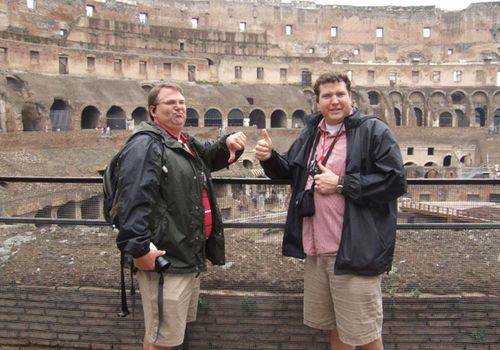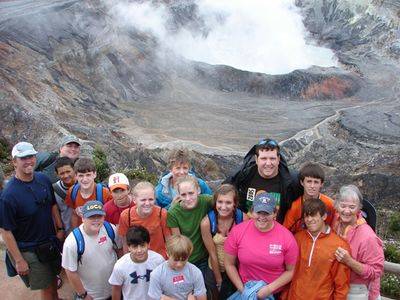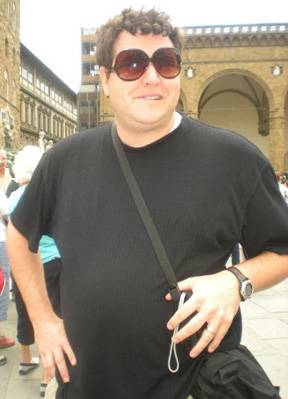Traveling has always been an integral part of Chad Brannon’s life. Now, as a middle-school science teacher in Alabama, Chad is making travel an important part of his students’ lives, too.
And he has the stories to prove it.
Ask him about the effect that educational travel has on his students, and he’ll tell you a story about the boy who once had no direction but now credits his tour for opening his eyes, or the boy who traveled to Costa Rica and now wants to major in Spanish education and help underprivileged kids speak English, or the girl who came out of her shell after braving the zip line through the Costa Rican rainforest.
Chad—pictured above on the right with his co-group leader, John DiPlacido—is preparing to lead his fourth tour with EF, taking his students back to Costa Rica in June. He took some time out of his busy spring break to share some of his favorite stories with us:
What inspired you to begin traveling abroad with students?
I grew up traveling. Before the age of 15, I had already traveled all over this country, Hawaii and England. We took road trips and went on cruises. Traveling has always been something that was important in my home. My dad was a teacher and did student tours, and I went on one with him my senior year. Obviously, my family inspires me and so do my friends.
All of my travels have been with fellow friends and teachers. I have never been on an EF tour without John DiPlacido. It helps to enjoy something this great with a team or friend. It all started in 2004, when a good friend and colleague was doing EF trips and sold me on them in a sentence or two: “Chad, would you like to go to London, Wales and all over Ireland with me and a group of kids?” Me: “YES!”
How do you decide where to take your students on tour? Where have you been, and where are traveling next?
I never make this decision alone. I always talk to my fellow travelers. This way, it is a group trip from the beginning. I have been all over with EF! My first trip was in 2005. We went to London, the English country, Wales, Dublin and the Irish country. I was not a leader on this trip, but I was able to be a chaperone and help where needed. My second trip was in 2007. We went to Costa Rica for 11 days. We went from coast to coast! My third trip was in 2008 to Italy, Paris and London. We are departing for Costa Rica again in June, and I can’t wait! I have not decided where to go next. I usually have our first meeting in April or late May the summer before we go. I know several group leaders that plan earlier, but this time works for us. For sure, you should start your trip at least 15 months in advance.
Why do you think it is important for students to travel on an educational tour?
EF is a great way for young people to learn about themselves and grow. I have never had a student traveler not realize at least some of their great potential while on tour. An educational tour can make the world seem small but somehow huge. Every kid has eaten a banana. But how many of them have physically walked through a banana plantation, processing area, then followed a truck to port to watch them get loaded on a ship? Simple things like an appreciation of produce can make a young person more introspective and self aware in a new global way. In today’s global world and global market, an international tour at a young age can be a life-changer.
You teach seventh-grade science, but you also consider yourself more than “just a teacher.” As a professional learning facilitator, how does international travel help prepare your students to learn?
Simple: It is hands-on, minds-on 24/7. They have to take care of themselves to a certain degree. Therefore, they are learning all the time. Many of these kids have never been out of the country before, and it can be a mind-blowing experience for a 14-year-old. I have seen kids that can’t stop talking stand in awe at the base of the Eiffel Tower and then change who they are because they see life in a different way. I know that sounds a little hokey, but it’s true. We had one kid that had no direction whatsoever, and his dad sent him on a trip. To this day, he still thanks John and me for showing him the world outside his little walls.
What kind of an effect does traveling abroad have on your students after they return home?
We have one kid that came back from Costa Rica speaking tons of Spanish. He wants to go to college and major in Spanish education, and he wants to go help underprivileged kids speak English. He will “pass it on” in a great way due to one of our EF trips. We had another kid go with us because he wants to go into science as a career. He spent 11 days in the jungles, forests and beaches of Costa Rica wanting to really help the world become a better place. It’s all about the kids and what they get out of it. Some kids just kinda roll through a trip, but every year, it changes the lives of at least a few of them. It is mind-blowing to see a kid realize how he/she can help the world with his or her talents.
How do you incorporate your tour experiences into your curriculum?
My favorite example of this is my biodiversity unit. I get to show slideshows of my travel to Costa Rica. Five hours of Costa Rican diversity and La Selva Biological Station discussion takes me back there more than once a summer. It makes me excited to teach. My kids really feed off of exciting topics. Half of them use the jungle or something similar when they get to choose a biome for one of their major projects.
You clearly are web-savvy—you have a fun and creative webpage for your students, and you also have embraced social-networking tools such as Twitter. How does technology help engage and prepare students to travel?
We do show a few websites to help them pack and see what they are in for. It is pretty cool to show a movie about the Poas Volcano and then walk up it a few months later. Everyone has heard of the Mona Lisa, but have you stood in front of it with a group of friends and fellow travelers and stared at it as long as you wanted? Having a group of kids walk through museums and natural wonders is a must for any teacher that loves to learn and loves to see true learning occur. When kids are covered in mud, grime and water, they lose many of those personal boundaries that get in the way in the classroom. When the jungle is your classroom, the kids really pay attention to what you say. My great friend and colleague, John DiPlacido, used to run a marine biology museum. He used to lead tours as a pro and has not lost his touch at all. I learn from him almost daily on tour. It really makes a difference when you travel somewhere more than once. You know where the learning opportunities are and how to use them. We always review at night and prep them for the next day of learning. They don’t act like they are in a classroom, so it makes them more aware of their surroundings.
Do you have any tips for recruiting students for your tours?
Talk it up and get the kids excited about it first. If the kids are interested in a tour, it will work. They have to want to go first. Then showing the package to the parents is easier. The value of the learning and travel gets the parents’ attention on its own.
How do you get your students excited to travel and keep their excitement up until the tour departs?
Easy. We are excited about the trip because it is a blast. We always do it a week or two after school ends, and it is the official start of summer learning. Whenever we get any information from EF about our trip, we pass it along immediately. They love looking at the hotels and stuff online before we go.
What is the most important thing for a group leader to know about taking students on an educational tour?
Be ready to be exhausted! You will come home and not realize that you have been gone for a week or more. Time flies. Enjoy all of it, even that time that the bratty and bawdy Irish kids “mooned” your bus because you just beat them at their own game of “cups and saucers!”
What’s your favorite tour story?
I could fill a book with my favorite tour stories. There are so many memorable moments on tour. We were in a park in Dublin walking around and taking in the beauty. A local school was on a field trip at the same time. We watched them play “cups and saucers” for some time. I struck up a conversation about the game with their teacher, and we got to take them on. Neither we nor our kids had ever heard of “cups and saucers,” but now they want to play it in PE all the time. Like I said earlier, it ended with a “full Irish moon!”
One of the funniest stories is of John. We were at Blarney Castle jumping around on these giant boulders, and he split his shorts from the bottom to the top all up the inseam. It was hilarious. You could hear the rip for a hundred yards. He then made a kilt, which the Irish don’t wear—it’s a Scottish thing. So we were coming out of the Blarney grounds heading to the bus and a little leprechaun-looking dude stopped us to try to get us to hear some of his Irish poetry, and John laid a crazy limerick of his own that ends in the Irish man laughing out loud. We trotted on to the bus for some more clothes and a good laugh on our own.
Another one of my great moments on tour was having close to the best pizza ever in Florence with my mom. We have had many a pizza together, but that one will forever be remembered by both of us. Having a family member on tour makes it a diverse learning experience.
John’s mother also has traveled with us. I won’t say how old she is, but she is in her mid-60s. We were in the middle of the jungle getting ready to get on a zip line and fly through the rainforest. There were several kids not sure if they could do it. When the last five travelers were left and one of them was Grand Ann, those young people knew they were not going to let themselves chicken out. This was a huge growing experience for someone who usually is not up for adventure. One kid came totally out of her shell after this experience. She realized she could do more than she thought. I bet she still carries this with her today.
What are your students’ favorite sights? What are yours?
I want to move into La Selva Bio station for a week. Every time we go there, I wander off and just enjoy the natural beauty of the place. It is inspiring. The kids love the zip lines, boat rides, subways and just about anything where they can interact with the locals and each other. They are so good at sharing learning with others.
What’s your dream travel destination—for your students? For yourself?
I want to try to start going further south of Costa Rica. Peru, the Amazon and the Galápagos would be a great trip. I haven’t set my 2010 trip yet, and this would be a great one. Got to see if the kids would buy in first!
Anything else you would like to share with our readers?
It is a bit of work. But, it is really great work. The rewards far outweigh the work. The hardest part of travel is waiting to do it again. A chunk of my life is working toward travel and exploring the world. There are so many more places that I want to go to.
We have a Photobucket account that lets everyone go online and share the pictures of others. Ever get home from a trip and realize that the photographer barely ever gets in the picture? I would not have that crazy picture of me (left) at the plaza of Florence, Italy, if it weren’t for Facebook.
Have fun and be flexible.
Related articles



